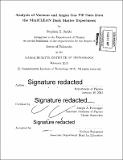Analysis of vacuum and argon gas fill data from the MiniCLEAN dark matter experiment
Author(s)
Jaditz, Stephen H
DownloadFull printable version (24.79Mb)
Other Contributors
Massachusetts Institute of Technology. Department of Physics.
Advisor
Joseph A. Formaggio.
Terms of use
Metadata
Show full item recordAbstract
The existence of particle dark matter provides a consistent framework for understanding many astronomical observations. The rotation curves of galaxies and galaxyclusters, for example, indicate the majority of mass in these structures is unseen. The existence of weakly-interacting massive particles (WIMPs) was proposed in the early 1980s to account for the anomalous rotation curves and provide a mechanism for producing the cold dark matter relic density, which along with dark energy is thought to dominate the current energy density of our universe. Efforts to observe the rare interaction of WIMPs with normal matter have continued since their proposal, and so far have set limits on the WIMP-nucleon interaction cross-section extending to 1 x 10-9 pb. Contemporary experiments seek to observe ~ one WIMP-nucleus scatter per year per 100 kg of detector mass. These experiments must be conducted deep underground with stringent cleanliness requirements. The MiniCLEAN dark matter experiment is a single-phase liquid argon scintillation detector which uses the wavelength-shifting fluor tetraphenyl butadiene and cryogenic photomultiplier tubes for light detection. The active spherical region of the detector contains 500 kg of liquid argon at temperature 87 K. Background events which could mimic a WIMP signal are mitigated through pulse-shape discrimination and position reconstruction. At an intermediate stage of ongoing detector assembly 2 km underground at SNOLAB in Ontario, the complete instrumented inner vessel was commissioned by collecting photomultiplier waveform data for periods when the vessel was evacuated and when filled with warm argon gas. Alpha decay events from radon progeny on the wavelength-shifting surface occur in this data at a measured rate of 19.0 ± 0.4 /h/m2 MiniCLEAN's projected sensitivity to spin-independent WIMP-nucleon scattering, derived from simulation of this surface rate, is [sigma]SI < 1.5 x 10-8 pb.
Description
Thesis: Ph. D., Massachusetts Institute of Technology, Department of Physics, 2015. Cataloged from PDF version of thesis. Includes bibliographical references (pages 183-193).
Date issued
2015Department
Massachusetts Institute of Technology. Department of PhysicsPublisher
Massachusetts Institute of Technology
Keywords
Physics.